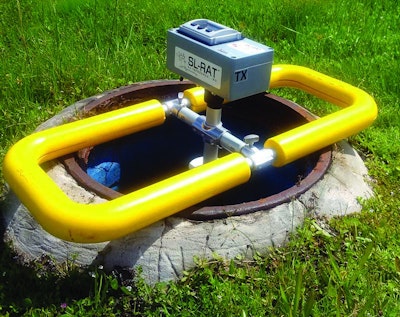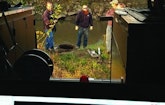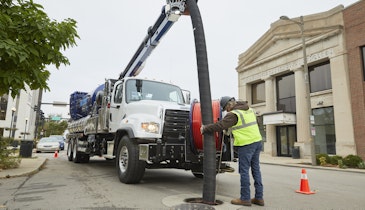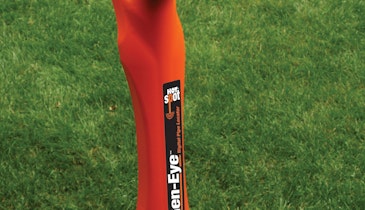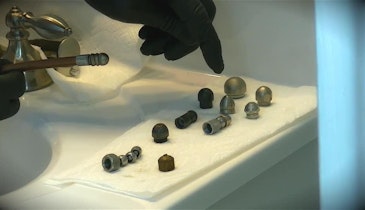Interested in Municipal/Industrial?
Get Municipal/Industrial articles, news and videos right in your inbox! Sign up now.
Municipal/Industrial + Get AlertsProgram allows city to scan 3,000 feet of pipe quickly
Problem: The city of Muscatine, Iowa, experiences high-flow conditions in its sanitary sewer interceptors that run through flood control levees on the Mississippi River. As a designated critical sewer, the U.S. Army Corps of Engineers ordered the city to inspect its interceptors on a regular basis. However, bypassing and dewatering high-flow pipes so they can be taken offline to accommodate CCTV inspection can be an expensive and time-consuming process, often with mixed results.
Solution: The city chose instead to use low-voltage conductivity to test its large-diameter mains. By turning off the pump station and allowing a temporary buildup in effluent flow, Electro Scan, in partnership with Municipal Pipe Tool, was able to inspect all 3,000 feet (12 segments) of 24- and 27-inch CIPP-lined RCP in less than a day and half. Additionally, defects often not seen on CCTV were located and quantified in gpm. All work was done in accordance with ASTM F2550 and newly issued 7th Edition, Volume 1, of the Operations & Maintenance Manual of Wastewater Collection Systems.
Result: While nine of 12 pipes had little to no defects, two segments had multiple defects. In fact, combined defect flows for the two pipes accounted for nearly 80 percent of the infiltration flows for the 3,000-foot project. The city was happy with the speed and efficiency of the project and the level of data provided. 800/975-6149; www.electroscan.com.
Sonar system used to identify blockages in long pipe run
Problem: A Kansas municipality needed to locate and clear a pipeline blockage in a line with a 10,000-foot reach. The downstream end had a valve that machinery could potentially become lodged in, complicating the project.
Solution: Hibbard Inshore used a submersible float with multiple sonars to identify the debris/blockage within the pipeline. Forward-looking sonar continuously updates, has a field of view of 120 degrees and can see objects up to 50 feet ahead of the vehicle. The company was able to obtain real-time feedback of the vehicle’s progress to ensure it did not swim past the valve. The forward-looking sonar also filled in the gaps between profiles to ensure they were not missing any areas of higher debris between scans and abnormalities.
Result: The forward sonar identified one such feature and its location — a grate that was at the invert of the pipe. If not dealt with, the grate may have been forced downstream into the valve over time, causing major operational issues. 248/745-8456; www.hibbardinshore.com.
Acoustic inspection reduces precleaning in CCTV inspection program
Problem: Hillsborough County, Florida, serves a population of over 500,000 in the area surrounding Tampa. They have set an internal goal of CCTV inspection of approximately 1,700 miles of gravity sewer over the next five years. Management wanted to maximize the efficiency of the process and target their precleaning efforts on the pipes that needed it.
Solution: The Sewer Line Rapid Assessment Tool (SL-RAT) from InfoSense was developed for rapidly identifying sewer line blockage conditions. It is based on measuring an acoustic signal transmitted between manholes in an active sewer line segment. Commonly encountered sanitary sewer defects such as roots, grease and breakages naturally obstruct acoustic energy; this changes the pipeline’s acoustic properties and produces a measurable impact on the acoustic profile. An algorithm is used to exploit these variations and provide a real-time evaluation of the segment’s blockage condition. A two-person crew can typically screen 2 to 3 miles of sewer per day. The units are GPS-enabled. Downloaded data can be visualized in Google Earth or integrated with a GIS system using SHP file exports.
Result: Hillsborough County purchased two SL-RAT units in mid-2015. In the first eight months of operation the technology had screened over 170 miles of their system and reduced unnecessary precleaning activity by over 80 percent, saving the county over $500,000 so far. 877/747-3245; www.infosenseinc.com.
Digital technology improves inspection efficiency
Problem: Taylors Fire and Sewer District in Taylors, South Carolina, is party to a 2006 agreement with Renewable Water Resources that requires elimination of inflow and infiltration in their wastewater collections system by 2021. This municipal subdistrict serves 10,000 parcels in central Greenville County, and is responsible for 130 miles of gravity line and 3,602 manholes. Aside from nine inline flow monitors and some spotty legacy analog inspection records, Taylors had no empirical system data. They’d need to inspect their entire system, identify problem areas, then plan, schedule and budget for rehabilitation.
Solution: In 2008, they replaced an old CCTV rig with a Ford F450, outfitted with a CUES K2 Base Station and TV reels. Inspection software now includes PipeLogix with Lateral Module, and the Cityworks/ArcGIS CMMS integrated digital utilities management package, used to locate assets, manage workflow, prioritize repairs and issue work orders. Taylors ports PipeLogix information directly to Cityworks for upper management to review work orders and work to date. The all-digital inspection system allows all units to connect and share data, decrease significant man-hours required by clunky analog systems, and eliminate errors introduced into analog data through a less-than-accurate analysis and reporting process.
Result: The efficiency has allowed the district to exceed their goal of inspecting at least 8 miles of line annually, with the project on track for completion by 2020. 866/299-3150; www.pipelogix.com.
Locator and camera system leads plumber to drainage issue
Problem: A Kentucky plant manufacturing solid rod towers and monopoles was having a drainage issue. The plant was bought from a previous owner, so the current occupants didn’t have drawings of the sewer lines for the building. They did know that the system consisted of old cast iron pipes buried in dirt under 8 inches of concrete.
Solution: The company owner called Logan Higginson of A-1 Septic & Plumbing Services in Henderson, Kentucky. Higginson used his Spartan Tool locator and Sparvision200 camera system to survey the pipes. He discovered that the entire plumbing structure ran underneath the 7-acre building. He was also able to use the locator to pinpoint the location of the problem. Scale buildup was causing debris to get caught in a pipe 7 feet underground. They would have to dig through the concrete and dirt to get to the pipe and replace it, using trench boxes for safety since the pipe was so deep.
Result: With the CEO and maintenance crew watching, digging started and A-1 led them directly to the problem. “Having (them) looking over your shoulder, then hitting your mark is awesome,” says Higginson. “I wish we would have gotten into this a long time ago.” 800/435-3866; www.spartantool.com.
